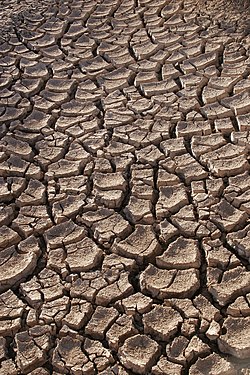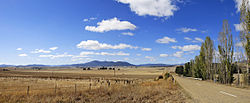Drought
Drought is a continuous period of dry weather, when an area gets less than its normal amount of rain, over months or even years. Crops and other plants need water to grow, and animals need it to live. Droughts can become dangerous to people and other land animals; causing famine and even creating deserts.
The word "drought" comes from the Old English drugað, drugoð "drought, dryness, desert," from Proto-Germanic *drugothaz, from Germanic root *dreug- "dry" (cf high/height) with *-itho, Germanic suffix for forming abstract nouns (see -th (2)).
A drought is a natural event, caused by other weather events like El Niño and high-pressure systems. Drought can also be triggered by deforestation (people cutting down forests), by global warming, and by diverting rivers or emptying lakes.
Drought is a natural disaster which usually takes place slowly. It is often difficult to decide when a drought started and sometimes when it ends too. Its effects often build up slowly over a long period of time and may last from months to years after rain resumes.
Many people die every year in famines due to drought in subsistence farming areas. Conflicts can result from drought conditions.[1]
Drought Media
Fields outside Benambra, Australia suffering from drought in 2006.
There will likely be multiplicative increases in the frequency of extreme weather events compared to the pre-industrial era for heat waves, droughts and heavy precipitation events, for various climate change scenarios.
Pair of dead oryx in Namibia during the 2018–19 Southern Africa drought.
After years of drought and dust storms the town of Farina in South Australia was abandoned.
Impacts of climate change on soil moisture at 2 °C of global warming. A reduction of one standard deviation means that average soil moisture will approximate the ninth driest year between 1850 and 1900.
References
| Wikimedia Commons has media related to Lua error in Module:Commons_link at line 62: attempt to index field 'wikibase' (a nil value).. |
- ↑ Texas Is Ordered to Supply Water to Crane Habitat March 12, 2013








